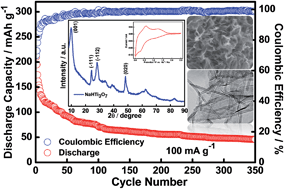3D flower-like NaHTi3O7 nanotubes as high-performance anodes for sodium-ion batteries†
Abstract
The synthesis and electrochemical performance derived from NaHTi3O7 have been investigated for use as an anode material for sodium-ion batteries. NaHTi3O7 nanotubes were fabricated by a hydrothermal method. Galvanostatic charge/discharge measurements were performed in a voltage range of 0.01–2.5 V vs. Na+/Na at different current densities, using the as-prepared NaHTi3O7 nanotubes as the working electrode. Typically, the initial discharge and charge capacities of NaHTi3O7 nanotubes were 381.80 mA h g−1 and 242.82 mA h g−1, respectively, at a current density of 20 mA g−1, and still retained a high specific capacity of 105.32 mA h g−1 and 100.65 mA h g−1 after 100 cycles. The electrode also exhibits outstanding rate capability with a reversible capacity as high as 300.95 mA h g−1 and 209.10 mA h g−1 at current densities of 50 mA g−1 and 100 mA g−1, respectively. The excellent electrochemical stability and high specific capacity of these nanostructured materials have been attributed to the three-dimensional flower-like morphology of NaHTi3O7 nanotubes. All of the findings demonstrate that NaHTi3O7 nanotubes have steady cycling performance and environmental and cost friendliness for use in next generation secondary batteries of sodium-ion batteries.


 Please wait while we load your content...
Please wait while we load your content...